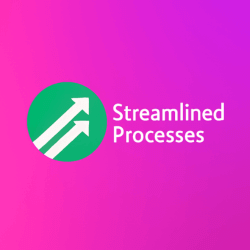For B2B Lead Generation Automation, see our main page here.
Why Automating B2B Lead Generation Matters
Most B2B teams spend too much time chasing leads instead of closing deals. Automation shifts that balance. It cuts down manual tasks, improves consistency, and maximizes your budget.
In fact, businesses using automation for lead generation see a 451% increase in qualified leads, according to research by Annuitas Group. That’s a massive impact driven by smart technology and streamlined workflows.
Automation isn’t just about bots and tools. It’s about creating a system that works 24/7 while your team focuses on high-touch interactions. Above all, it ensures no potential lead slips through the cracks.
Key Components of B2B Lead Generation Automation
To create a powerful automated lead system, several technologies must work together. Here’s what it typically includes:
- Data Enrichment Tools: Add firmographic or demographic data automatically to lead profiles.
- Email Drip Campaigns: Nurture leads with sequences that respond based on behavior or timing.
- CRM Integration: Sync lead data, track progress, and automate follow-ups.
- Landing Page Builders: Auto-capture lead data through smart forms and surveys.
- AI Scoring Engines: Rank leads by quality so your sales team knows where to focus first.
Each tool can run separately, but when used together, they form the backbone of B2B Lead Generation Automation workflows.
Benefits of Using B2B Lead Generation Automation
Most importantly, automation saves time. But the advantages go well beyond that:
- Scalability: Serve thousands of leads without hiring new reps.
- Faster Response Times: Automated replies reduce lead drop-off rates.
- Consistent Messaging: Every lead hears the same brand story, in the right order.
- Refined Targeting: Learn from user behavior to personalize content automatically.
Take the example of a SaaS marketing agency that implemented an automated funnel. Within 90 days, they reduced cost-per-lead by 60% and doubled demo bookings. It shows just how transformative automation can be for real businesses.
Challenges to Watch Out For
B2B Lead Generation Automation isn’t plug-and-play. If not set up carefully, it can backfire. Here are common pitfalls:
- Poor Lead Quality: Don’t let automation fill your funnel with unfit prospects.
- Over-Automation: Leads should still feel human interaction at key moments.
- Data Privacy Risks: Automation often involves handling sensitive customer data. Always stay GDPR and CCPA compliant.
- Integration Gaps: Tools must talk to each other. Otherwise, leads fall through.
Successful teams avoid these by building thoughtful workflows and testing often. In short, automation is a tool—not a substitute for strategy.
Top Tools for B2B Lead Generation Automation
The right tools boost efficiency, but choosing them wisely is key. Here’s a breakdown based on function:
- HubSpot: Merges CRM, marketing automation, and email campaigns under one roof.
- Outreach.io: Ideal for sales teams focusing on outbound sequences.
- LinkedIn Sales Navigator + Expandi: Automates LinkedIn prospecting while staying personalized.
- Clearbit: Automates lead enrichment with real-time firmographic data.
- Zapier: Connects nearly any platform, creating endless automation possibilities without code.
Choosing the right toolset depends on your business model and sales process. Therefore, always match your tools to your goals.
Crafting an Effective B2B Automation Workflow
Automation doesn’t eliminate strategy—it enhances it. A winning workflow might look like:
- Capture leads with gated content or contact forms.
- Auto-route new leads through enrichment software (e.g., Clearbit).
- Score leads based on behavior or firmographics.
- Send lead to CRM with trigger-based email sequences.
- Alert sales when lead hits a qualified score or takes high-value actions.
Furthermore, data from each step can inform your long-term decisions. In the same vein, automation lets you test what works without risking full campaigns.
How AI is Changing Lead Generation
B2B Lead Generation Automation keeps evolving. Artificial intelligence is the biggest recent shift. AI tools now do more than just score leads—they can:
- Create personalized emails based on behavior and company size.
- Predict churn based on historical interaction patterns.
- Analyze call transcripts to surface objections and opportunities.
For example, tools like ChatGPT (including AI like the one assisting with this article) can pre-write sequences, suggest subject lines, and summarize lead conversations. That’s not just time-saving—it’s competitive advantage.
This article was created with the assistance of AI tools and reviewed by our team at Streamlined Processes LLC to ensure accuracy and relevance.
What “Human-Centered” Automation Looks Like
A key trend for 2024 and beyond: blending automation with empathy. B2B buyers want relevance, not robotic emails.
So, companies are now mixing automation with real-time human interaction. For instance, sending event triggers to reps when a high-value lead clicks pricing pages—or integrating live chat at decision points.
In other words, automation should support—not replace—your best people. Smart systems carry the load, but humans still close the deal.
FAQs About B2B Lead Generation Automation
Do I need a developer to set up automation?
Not always. Many tools like HubSpot or Mailchimp offer drag-and-drop workflows. However, if you’re integrating APIs or creating custom flows, developer input helps.
How long does it take to see results?
That depends on your industry and sales cycle. Most users start seeing increased engagement or conversions within 30–90 days.
Can I automate LinkedIn outreach?
Yes, tools like Expandi and Zopto handle LinkedIn automation. But use them wisely to avoid spam flags. Personalized outreach works best.
How do I measure success?
Track KPIs like lead conversion rate, time to first contact, email engagement, and cost per lead. Automation should improve at least two of these.
In Conclusion: Automate Smarter, Not Harder
B2B Lead Generation Automation is no longer a luxury—it’s essential. When done right, it amplifies your efforts, reveals better leads, and shortens sales cycles.
Still, it should be part of a larger strategy. Technology is powerful, but only when combined with thoughtful planning and ongoing testing.
Keep tools light, workflows focused, and your message personal. That’s how real automation meets real results.
Follow us on Facebook here.

